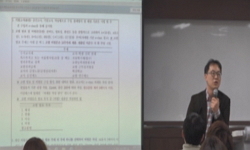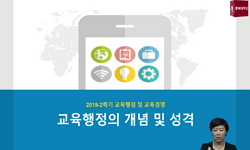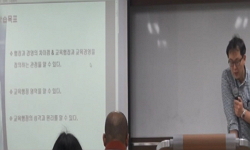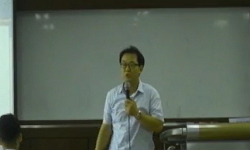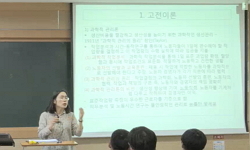새로운 학교문화를 창조하고 바람직한 교육문화발전을 위해서는 우리자신의 문화를 되돌아볼 필요가 있다. 또한 문화를 상대적으로 보는 안목을 가질 필요에 의해 교사와 학생이 인식하고 ...
http://chineseinput.net/에서 pinyin(병음)방식으로 중국어를 변환할 수 있습니다.
변환된 중국어를 복사하여 사용하시면 됩니다.
- 中文 을 입력하시려면 zhongwen을 입력하시고 space를누르시면됩니다.
- 北京 을 입력하시려면 beijing을 입력하시고 space를 누르시면 됩니다.
https://www.riss.kr/link?id=T7918679
- 저자
-
발행사항
인천 : 인천교육대학교 교육대학원, 2001
-
학위논문사항
학위논문(석사) -- 인천교육대학교 교육대학원 , 초등교육행정전공 , 2001. 2
-
발행연도
2001
-
작성언어
한국어
- 주제어
-
KDC
370.13
-
발행국(도시)
인천
-
기타서명
A Survey of Teacher and Student Cognition
-
형태사항
ⅵ, 69p. ; 26cm
-
일반주기명
2003년 3월 1일부로 인천교육대학교에서 <경인교육대학교>로 교명 변경
권말 참고문헌 수록 - 소장기관
-
0
상세조회 -
0
다운로드
부가정보
국문 초록 (Abstract)
새로운 학교문화를 창조하고 바람직한 교육문화발전을 위해서는 우리자신의 문화를 되돌아볼 필요가 있다. 또한 문화를 상대적으로 보는 안목을 가질 필요에 의해 교사와 학생이 인식하고 있는 학교문화를 문화의 네 차원에 근거하여 조사 비교하여 교사와 학생의 문화인식 정도를 진단하고 새로운 학교문화를 형성시켜나갈 수 있는 방향을 모색해 보고자 3가지 연구문제를 설정하고 실증적인 분석을 하였다.
학교문화 분석을 위한 설문지를 지도교수의 자문을 구해 작성하고, 안산과 안양지역 소재의 초등학교에 근무하는 교사와 5, 6학년 학생을 대상으로 배포하였고회수된578부를대상으로통계처리하였다.자료의처리는SPSS/Win program을 이용하였으며, 신뢰도검증과 유의수준을 함께 실시하였다. 설문지의 반응결과를 교사의 성별, 학교규모별, 경력별, 지역별로 구분하여 비교 분석하였고, 학생의 경우 학생의 성별, 학년별, 지역별로 구분하여 비교 분석하였다. 그리고 교사와 학생의 인식의 차이를 알아보았다.
이상의 통계처리에 의한 연구결과를 요약하면 다음과 같다.
첫째, 교사는 교사라는 동질문화를 인식하고 있으며, 규모가 작은 학교에서 근무하는 교사들과 경력이 5년미만의 교사집단에서 더 여성적 문화를 인식하고 있으며, 불확실성 수용 문화를 갖고 있다고 분석되었다. 이는 학교 규모가 작을수록 덜 경쟁적이고, 교사상호간에 친밀감이 높으며, 불안감을 적게 느끼는 것으로 해석된다. 또한 안양지역에서 근무하는 교사들이 더 남성적인 문화를 인식하고 있었다.
둘째, 학생들은 남학생이 여학생보다 집합주의문화에 높게 반응하였으며, 남학생이 더 남성적 문화를 인식하고 있었다. 또한 5학년 학생들이 권력거리를 더 크게 느끼고 불확실성회피의 경향이 큰 것으로 분석되었다. 학년이 낮을수록 의존성이 높은 현상으로 해석되며, 학생이 다니고 있는 학교 지역에 따른 인식의 차이에서는 안산지역의 학생들이 안양지역의 학생들보다 권력거리를 크게 인식하고 있다고 분석되었다.
셋째, 교사와 학생의 학교 문화인식의 차이는 학교문화 진단의 목적을 위한 인식비교로서 교사가 학생들보다 더 여성적이며, 불확실성회피경향이 약한 것으로 분석되었으며, 이러한 결과는 교사와 학생이라는 위치에서 얻어지는 것으로 해석된다.
넷째, 문화의 차원별 교사 학생의 학교문화 인식의 분석에서는 차원별로 독특한 반응을 보인 항목을 중심으로 교사와 학생의 문화인식을 분석하였다. 권력거리에서는 교사의 신뢰와 순종 면에서 높은 반응을 나타내었으며, 집합주의 문화와 개인주의 문화에서는 배경이 비슷한 사람끼리 친밀감을 갖고 있고 남성적 문화와 여성적 문화에서는 역할분담의 순번제와 공동책임을 묻는 항목에 대한 교사와 학생의 시각차이가 있음을 알 수 있었다. 불확실성회피경향에 대한 반응으로는 문제의 정답이 하나여야 한다는 점에서 교사와 학생의 반응이 높게 나타났다.
이와 같은 결과를 바탕으로 첫째, 교사의 학교문화인식조사를 통해 경력별, 학교 규모별, 지역별로 문화인식의 차이가 있는 것으로 교사들이 학교문화를 만들어간다 생각을 가지고 성공적인 학교를 만들기 위한 노력이 필요하며, 학생들의 학교문화인식조사로 학년과 지역에 따라 인식의 차이를 알 수 있었으며 학생들의 문화적응은 사회 경제적인 영향을 많이 받아 빠르게 변화한다면 교사들도 변화에 적응하는 노력이 요구되며,
둘째, 교사와 학생의 학교문화 인식에서 나타난 바로 문화인식의 공통점이 있었으며 이는 한국인의 문화전통에 근거를 두고 있다는 것을 알 수 있었다.
셋째, 문화의 네 차원별 인식 비교를 통해 교사와 학생의 학교문화 인식의 차이를 발견할 수 있었다. 학교, 학급에서 문화차이를 줄이려는 노력이 필요하다. 학생들의 문화인식조사를 통해 학생들의 요구와 기대를 알아볼 수 있었는데 이것은 중요한 교육활동의 하나가 될 것으로 결론을 얻었다.
그리고 학교교육의 정상화를 위해서는 교육정책 입안자는 새로운 정책을 세울 때 먼저 학교문화의 진단을 위한 학교구성원 전체에 대한 문화인식 연구가 필요함과 학교문화인식의 연구에서 각 차원별 문화의 상관관계를 알아보는 연구가 있어야함을 제언하였다.
다국어 초록 (Multilingual Abstract)
To create new school culture and boost the desirable development of education culture, it's needed to reflect upon our own culture and to have a relative view on culture. The purpose of this study was to seek ways to create new school culture, by maki...
To create new school culture and boost the desirable development of education culture, it's needed to reflect upon our own culture and to have a relative view on culture. The purpose of this study was to seek ways to create new school culture, by making a comparative analysis of what teacher and student thought about it in terms of four cultural dimensions. For the purpose, three research questions were posed, and an experimental analysis was made.
The school culture questionnaire was prepared by advice from my advisor, and then distributed among teachers, fifth graders and sixth graders in elementary school in the city of Anshan and Anyang. The collected 578 questionnaires were analyzed by SPSS/WIN program, and reliability and level of significance were tested. The responses from the teachers were analyzed by gender, school size, career and geographic region, and the responses from the students were analyzed by gender, grade and geographic region. And then the difference between the teachers and students was examined.
The brief findings of this study were as below:
First, the teachers investigated recognized they had a homogeneous culture as a teacher. The groups who worked in smaller school or had less than 5-year career perceived school culture to be more feminine, and owned more uncertain, acceptable culture. This could be interpreted that the teachers in smaller school were less competitive, had higher intimacy with one another, and felt less anxiety. Those who worked in Anyang considered school culture more masculine.
Second, more boy students regarded school culture as collective one than the girls, and thought school culture was more masculine. The fifth graders felt more power gap and had stronger tendency to avoid uncertainty. This could be interpreted that the lower graders had higher dependence. By school location, the students in Anshan felt more power gap than those in Anyang.
Third, as a result of comparing the views of teacher and student on school culture to diagnose school culture, it's found that the teachers found it more feminine and had less tendency to avoid uncertainty. This result might be caused by their position as a teacher and as a student.
Fourth, the awareness of teacher and student about school culture was analyzed by cultural dimension, and higher attention was paid to the items to which they showed a unique response. Concerning power gap, teacher confidence and obedience drew more frequent response. For collective and individual culture, those who had similar background felt more intimacy with one another. In masculine and feminine culture, the teachers and students were of a different opinion about role division rotation, and joint responsibility. Regarding uncertainty avoidance, many of the teachers and students agreed that there should be one correct answer to a question.
The following conclusion might be reached from the above-mentioned findings:
First, as the cultural awareness of the teachers was different according to career, school size and geographic region, teachers need to think of themselves as the co-creator of school culture and to generate successful school. The students also had a different view on school culture according to grade and geographic region. If students could adjust themselves to culture swiftly under the influence of socioeconomic influence, teachers also need to make efforts for more successful, prompt adjustment to the given change.
Second, there was something in common between the teacher and student groups' awareness of school culture, which might stem from the common cultural heritage.
Third, there also was a gap between the two groups' cognition of school culture, as a result of making a comparison in terms of four cultural dimensions, and it's needed to lower cultural gap in school and classroom. In addition, the survey of the cultural awareness of the students showed what they asked of and expected from school, and this information might serve to make education activity more successful.
To normalize school education, policy makers have to turn their eyes first to school culture. How school culture is viewed by every school organization member should be identified, and the correlation between four cultural dimensions also should be explored.
목차 (Table of Contents)
- 목차
- I. 서론 = 1
- 1. 연구의 필요성 및 목적 = 1
- 2. 연구문제 = 2
- 3. 연구의 제한점 = 3
- 목차
- I. 서론 = 1
- 1. 연구의 필요성 및 목적 = 1
- 2. 연구문제 = 2
- 3. 연구의 제한점 = 3
- II. 이론적 배경 = 4
- 1. 문화의 개념 = 4
- 2. 문화와 교육의 관계 = 9
- 3. 문화분석의 네 가지 차원 = 19
- 4. 학교문화 분석 = 28
- 5. 선행연구의 고찰 = 35
- III. 연구의 방법 = 37
- 1. 질문지 작성 = 37
- 2. 조사 대상과 설문지 회수 = 39
- 3. 자료처리 및 분석방법 = 40
- IV. 연구결과 및 해석 = 41
- 1. 교사의 문화인식 = 41
- 2. 학생의 문화인식 = 46
- 3. 교사와 학생의 문화인식 비교 = 50
- 4. 문화의 차원별 교사와 학생의 인식 분석 = 51
- V. 요약 및 결론 = 56
- 1. 요약 = 56
- 2. 결론 및 제언 = 58
- 참고문헌 = 60
- 부록 : 설문지 = 62
- ABSTRACT = 68






